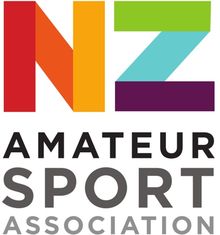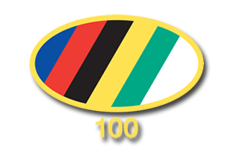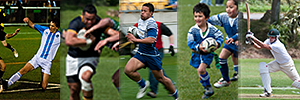Wellington's Ghost Clubs Part 8: Kia Ora from Lower Hutt
Above: A famous cartoon immortalising an incident in 1901 on Kia Ora's home ground of Butler's Paddock (on or near modern-day North Park, Petone) where the visting Wellington Football Club 'second XV wing was met by a stray bull on the tryline, forcing him to turn back and run away. Kia Ora won the game.
WELLINGTON’S “GHOST” RUGBY CLUBS
Part 8 – “Kia Ora” From Lower Hutt
The expression “kia ora” was first widely popularised in New Zealand by the Duke of Cornwall and York (the future King George VI), during his visit to New Zealand in 1901. It was said that the phrase found its way into nearly all of his public statements, a fact which was celebrated throughout the country.
However, before the Duke’s visit, “kia ora” was not a common Maori expression. It is said to have originated at the turn of the 20th century “from Maoris hearing Europeans, when having a glass of wine, saying “good health”. They naturally asked the meaning of “good health” and were told that the greeting meant “kia ora”, that phrase being the nearest equivalent to “good health”. It was therefore only used for some years when Maori were having a drink together.
It’s therefore no surprise that this history has a direct bearing on the name of Lower Hutt’s Kia Ora Football Club, which was founded in 1898. Maurice (“Mot”) Welch, the founder of the Club and a former Petone Club member recounted that he “called a meeting to form another Club in the Hutt”. He recalls, “we had a very successful gathering and were unanimous about forming the club, but the name had to be selected. [As we] were having some liquid refreshments, one man said “kia ora”, to which I immediately said, “call the club ‘kia ora’ – which we did. The man who issued the Maori toast, was most likely Tutua Wiremu Hapi Puketapu or Pitama Tahurangi, both of Waiwhetu, of who more will be said shortly.
For the record, the Lower Hutt “Kia Ora” club was not the first football club of that name in New Zealand. Records reveal a Kia Ora Football Club based in Palmerston North in 1894, in Woodville (1898) and later in Hawke's Bay (1899) and Wanganui (1907). In all cases it can be safely assumed that the origins of the club name were similar.
The new club (largely comprising players from the Petone and former Epuni clubs, the latter club named after the Te Puni family), was admitted as a Junior Club to the Wellington Rugby Union in April 1898.

Initially entering teams in the Junior Championship and Third Grade Competition, Kia Ora’s first team comprised: Jack Puketapu (who became a Wellington league representative after World War One); Jones; Jackson; J. Brown; Welsh; Poster; Williams; Archer; Arthur Judd (known as “the wild man of Borneo” for his style of play); Herb Judd (a master at “screwing the scrum”); Oswin; Wilkie; Paul; Morris; Benge; Greenhaugh; Pyke; Apps; Mabey; and Hayes.
The founding Patron of the Club was William Hughes Field (the Member of Parliament for Otaki) and the Club President was Edmund Percy Bunny (later to become Mayor of Lower Hutt in 1900 and 1909). Andrew Walker Stevens (known popularly as "Doggy" Stevens because of his association with the Wellington Kennel Club), was the delegate to the Wellington Rugby Union and a member of the Union’s Management Committee.
From its earliest days, the club developed a poor reputation arising from its parochial supporters. In a match against Athletic in the Junior Championship in 1898, “the disgraceful behaviour of a pronounced partisan of the losers” was noted. Mot Welch “the whole-souled supporter” of Kia Ora was to run into conflict with the Wellington Rugby Union, as Club Captain, on more than one occasion. (In 1905, following referee abuse, the Club was refused any more home fixtures for the remainder of the season.)
In May 1901, a memorable match was played at Kia Ora’s home ground, “Butler’s Paddock”. The ground comprised two playing fields opposite the Petone Show Grounds in Petone, (North Park is likely a remnant of “Butler’s Paddock”). In the match, against the Wellington Club’s 2nd Fifteen, “a speedy Wellingtonian was streaking for the goal-line to score a certain try.”
“A roar from the goal-posts and there stood Kia Ora’s reserve force, with tail in the air, and quite ready for the action. That speedy three-quarter dropped the ball like a hot potato and never made faster time in his life when he started for the other end of the field. Never before was such a panic seen on a football field”! The “reserve force” was a stray bull, that had found its way on to the field. Kia Ora won the match, and the event was immortalised in a famous press cartoon.
In 1904, having been unbeaten over a nine-match season, Kia Ora played Petone in the final for the Junior Championship at Athletic Park, securing the services of former All Black (1893) Wally Pringle and former Wellington representative Mick McGurk, in their quest to win the title. While reports of “systematic training” during the season culminated in their best result since forming in 1898, it was Petone who won the day.
In 1906, the Club applied to the Hutt Borough Council for the use of two grounds at the Lower Hutt Recreation Ground. At that time, owing to not having a gymnasium, the Club was reported to practice in a tent. The same year, the Epuni players decided to leave Kia Ora and re-establish their old club at Porutu Street in Epuni (the land originally owned by Ihiai Porutu, but on his death bequeathed to Hapi Puketapu and others).
Hapi Puketapu was a prominent landowner in the Waiwhetu area, a supporter of both cricket and rugby, but not a successful businessman. In 1898, the year of Kia Ora’s formation, Puketapu was declared bankrupt on his own application. He had obtained loans on land he owned, which he was unable to repay. Together with Rota Paki, he had owned the Railway Hotel on Thorndon Quay and a number of racehorses. In 1904, Puketapu died, with over 1,000 attending his tangi. Pitama Tahurangi, a close friend who was also from Waiwhetu, was also with Puketapu, a founding member of the Kia Ora Club.
Kia Ora once again played in the final of the Junior Championship against Petone in 1908, this time at the Lower Hutt Recreation Ground. “Nearly a thousand people, many going from town, paid for admission, and with the free contingent, the crowd was estimated at thirteen hundred.” The match, which again featured a Wellington representative, John Tannahill (a life member of the Kia Ora club) in the Kia Ora side, was drawn 3 points all. Tannahill was subsequently judged ineligible to play and the championship was awarded to Petone.
The Club’s sole championship victory in Wellington rugby was earned the following year in 1909, when the team won the Junior Championship, coached by Jacob (Johnny) Baumber, a former Petone and Wellington representative. The title was won with a 3 points to nil victory over the Athletic Club.
Following their success, the Kia Ora club community undertook successful fund-raising to build a new gymnasium on land gifted by William Stephen Judd, on Judd’s proviso that the club be re-named the “Hutt Football Club”. (While the deal was agreed, the Kia Ora sold the land and eventually built a gymnasium on what is now Strand Park.)
The same year, following consultation with “the Epunis”, it was decided to disband both the Kia Ora and Epuni clubs and create a new Senior club, to be called the Lower Hutt Football Club, (later abbreviated to the Hutt Football Club), playing in green jerseys with gold hoops.
While Kia Ora Football Club is no more, it’s interesting to note it’s close historic relationship with Petone and in its successor, the Hutt Old Boys Marist Club. The friendly rivalry between both Petone and Hutt Old Boys today, has a common historic connection. A toast then, to game of rugby union in the Hutt Valley – “Kia Ora”!
Steven White, 19 Mar 2019
Adam Julian, 19 Mar 2019
Steven White, 12 Mar 2019
Adam Julian, 04 Mar 2019
Steven White, 12 Feb 2019








.jpg)






